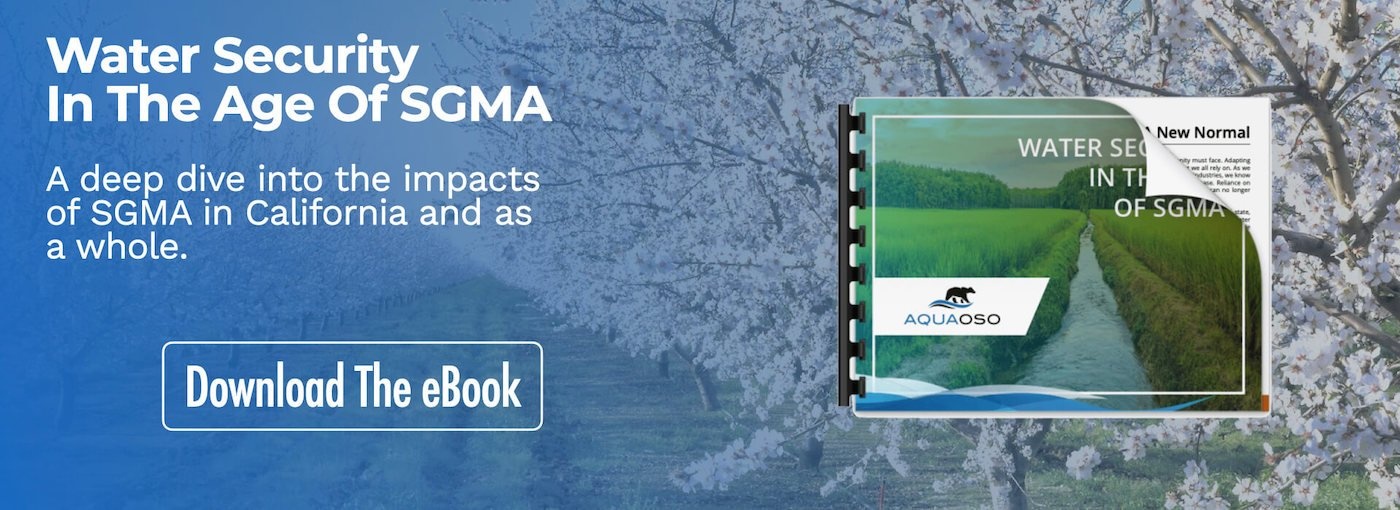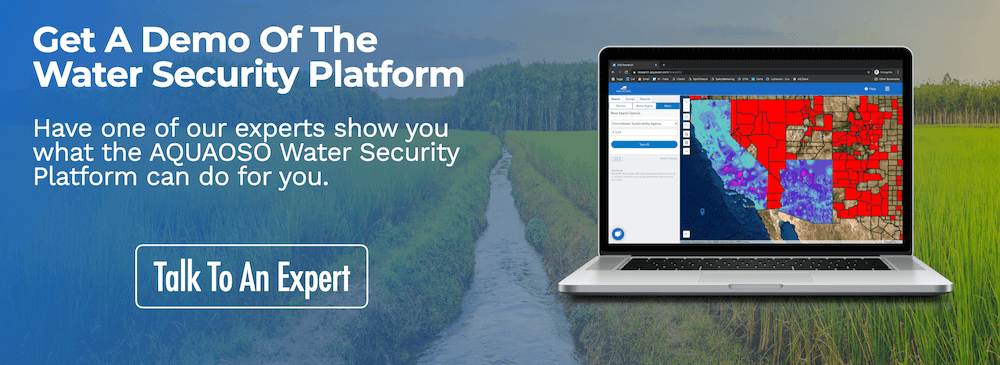How Appropriative Water Rights Work in Ag Lending and Investing
In many parts of the U.S., it’s access to water, not land, that ultimately determines which crops a farmer can grow. An article in Nature reports that, “although it uses only 20% of cultivated lands, nearly 50% of agricultural production relies on irrigation.”
As a result, anything that impacts water availability, including water rights, can “shape crop yield and revenue volatility,” especially in regions that rely on snowmelt. Most of the country’s core agricultural regions use a system of appropriative water rights, so understanding these rights is key to making good agricultural lending decisions.
In fact, a statement that AQUAOSO hears from stakeholders more often now is:
“People don’t buy land anymore, they buy access to water.”
That’s how important water rights are to agriculture investing and lending. In this article, we’ll take a close look at how appropriative water rights work, and how to perform due diligence on them before approving a loan or deciding on an investment.
(Part of our Water Rights Guide. Explore the full guide here.)
What Are Appropriative Water Rights?
Most states use one of two systems to determine what water rights are associated with a particular parcel of land: appropriative and riparian. Riparian rights are more common east of the Mississippi River, while many areas in the West use an appropriative rights system. Note that California, however, uses a unique hybrid system that combines both types of rights.
In general, the distinction between the two types of rights is as follows:
- Riparian rights are linked to a specific parcel of land and provide the right to use the water that naturally flows through or alongside that land and cannot be sold as separately from the land (though a parcel of land can be sold without transferring the rights attached to it)
- Appropriative rights allow for the diversion or transfer of water from a particular source, such as a river, even if it doesn’t touch the piece of land in question; appropriative rights can be bought and sold more easily
In short, riparian rights are determined by proximity, while appropriative rights are based on seniority. Under an appropriative water rights system, junior rights holders may have reduced access to water during a drought, even if the water source in question passes their property first. This is one reason why it’s so important to know what kind of rights are associated with a particular property and what their “priority date” is.
Most states use either one system or the other. However, in California, water rights are a hybrid.
How Appropriative Water Rights Work
The concept of appropriative water rights was established during the Gold Rush in the mid-1800s, with miners posting a notice of the water they intended to use in the course of their mining operations. This practice was recognized by the courts and the general principle continues to this day. Water users must apply for a permit that outlines when and how the water will be used, including the date that they first appropriated it.
The most senior rights holder has priority, and as the Water Education Foundation says, “when there is not enough water in the stream to satisfy all claims, the most recent claim is the first to curtail its diversion…. If the water shortage is extreme, even the most senior appropriators will be required to give way to all riparian rights on the water source.”
This means that it isn’t enough to know whether or not a piece of land has appropriative water rights attached. Lenders and investors must also be aware of the priority date on the claim and any additional conditions attached because it can determine whether or not the grower will have access to sufficient water resources to grow their crops.
Can You Lose Them?
Unlike riparian rights, which typically remain valid even if they’ve been dormant for an extended period, appropriative rights can be lost over time. One way that water rights can be lost is if a grower stops using them for several years in a row. In California, the timeframe is five years, but this can vary from state to state.
Growers can also lose a portion of their water rights if they don’t use their full allocation each year. If a grower switches to less water-intensive crops, for example, they may not be able to return to more intensive water use in future years.
This means that lenders and investors need to do due diligence and ensure that a water right is valid in practice – not merely that it exists on paper.
Buying and Selling Appropriative Water Rights
Another distinction between the two rights is that appropriative rights can be bought and sold more easily. While riparian rights can only be transferred along with the land itself – and don’t allow for long-term water storage – appropriative rights can be sold to other water users permanently, or leased on a temporary basis.
Some states even set up water markets that make it easy for rights holders to sell their excess water. In other regions, water banks allow water users to store or get credit for unused water. This reduces the incentive to use more water than is needed in order to maintain a full allocation in future years.
Why Appropriative Water Rights Matter to Lenders and Investors
Water scarcity trends can be hard to keep track of. One thing that lenders and investors can do, however, is determine whether or not a water right is still valid.
By learning how water rights differ from state to state, and by researching which water rights are attached to a piece of agricultural land, lenders can make sound loans and ensure that the land will have reliable access to water in the years ahead.
Without a reliable water source, agricultural land won’t be worth much, and the cost of buying additional water may be prohibitive. In a time of water scarcity, a piece of land that seems like a sound investment can quickly become a liability.
How AQUAOSO can help
Historically, performing a water risk assessment has taken quite a bit of time and effort, and may have required on-the-ground research and expensive consultants. New tools, however, are making it easier to stay on top of water security issues.
In particular, AQUAOSO’s Water Security Platform can help agriculture professionals find the information needed concerning water rights. In addition to looking up appropriative water rights on a parcel-by-parcel basis, users can find up-to-date information on soil and water quality, view the boundaries of groundwater basins and irrigation districts, and more.
The tools in the water security platform can help lenders, investors, growers, and others stay on top of SGMA’s reporting requirements and work closely with growers and other stakeholders to monitor appropriative water rights – all without having to spend weeks and capital during due diligence.
Read more about how water rights are closely correlated to water risk in the full Water Rights Guide.
The Bottom Line
Factoring water rights into loan and investment decisions can be one of the most challenging parts of agricultural financing. Not only do water rights vary from state to state, but even the rights attached to a specific parcel of land can change over time, based on priority date, water rights transfers, and environmental conditions.
AQUAOSO’s Water Security Platform was designed specifically to help ag professionals perform due diligence on water rights and avoid investing capital in parcels that could cause water risk.
Learn more about current trends on our resources page, or sign up for our newsletter. You can also schedule a free demo or chat with one of our water security experts.
Recent Posts
Agcor and AgWare Celebrate 2 Years of Groundbreaking Integration, Setting the Standard in Agricultural Appraisal Efficiency
PRESS RELEASE For Immediate Release DENVER, March 21, 2024 -- Agcor, an AQUAOSO Technologies, PBC brand, a leading provider of agricultural lending software solutions, announces a significant milestone in its partnership with AgWare, a premier developer of innovative...
AQUAOSO launches Agcor – a full suite of digital tools for the modern ag lender.
PRESS RELEASE For Immediate Release Denver, CO - Today, AQUAOSO Technologies, PBC officially unveiled Agcor™ - a suite of software tools for the modern ag lender. The software is purpose-built by and for agricultural lenders to unlock the power of...
AQUAOSO’s Climate Intelligence Platform Showcased At OnRamp Conference
PRESS RELEASE For Immediate Release AQUAOSO showcases GIS Connect, a climate intelligence platform that helps US financial institutions mitigate climate risk during the recent OnRamp Agriculture conference. AQUAOSO shares their story of substantial growth as...



